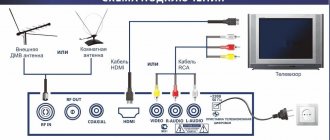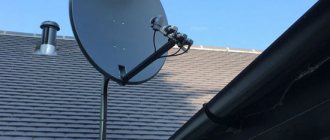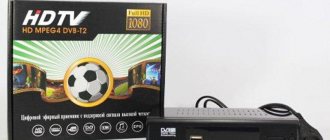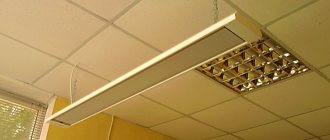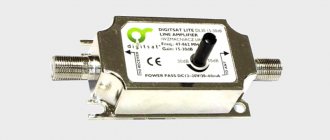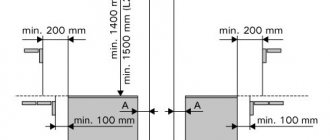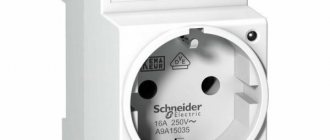First of all, GPS antennas should be divided into passive and active. In addition, there are antennas external and for mounting on a board. These two classifications of GPS antennas are the main ones. Manufacturers offer antennas of various types. It should not be forgotten that antennas are one of the most important components of wireless systems. No matter how wonderful the equipment is, if the wrong antenna is used, then the performance of such a system will be very far from desired. Active antennas are passive antennas with a built-in low noise amplifier. When should you use active antennas? Firstly, if the GPS receiver does not have the ability to install an internal antenna - for example, when the connector for connecting an external antenna is removed, then, of course, the best option would be to use an active antenna rather than a passive one. This will not only increase sensitivity, but also increase the signal-to-noise ratio and reduce the influence of interference (a weak signal traveling along the cable from a passive antenna is more susceptible to external electromagnetic radiation than a signal from an active antenna of much greater amplitude). In the absence of a connecting cable (or in the case of an extremely short length that can be neglected), the need to use an active antenna is dictated by the specific situation: if a new device is being developed, then in many cases it may be more convenient and cheaper to integrate an antenna amplifier directly into the device. Ready-made devices may already contain such an amplifier, so the choice of antenna type must be approached individually.
Let's look at some antenna models offered by various manufacturers. Laipac offers a range of antennas for wireless devices, both external and internal. P1 patch antenna series is an external active antenna for GPS devices (Fig. 1).
Rice. 1 . Appearance of the Laipac P1 antenna
It has small dimensions, is housed in a case protected from external influences and comes with a cable with MMCX, SMA and MCX connectors. The case has a magnetic base, which in most cases greatly simplifies its installation at the work site. The antenna has a built-in high-tech modern low-noise amplifier. A wide variety of connectors are available (which can be expanded by supplying antennas with custom connectors). The antennas are available in two versions: for systems with a supply voltage of 3.0 V and for systems with a supply voltage of 5.0 V. In addition to good gain, the LNA contains bandpass filters that cut out all signals outside the operating frequency range of GPS. Let's look at the main performance characteristics of the antenna. The operating frequency is 1575.42±3 MHz, while the VSWR does not exceed 2.0. The bandwidth, taking into account the operation of bandpass filters, is 10 MHz. The antenna has an ellipticity coefficient of 3.0 dB, its impedance is 50 Ohms. The maximum gain of the antenna itself reaches 4.0 dB, and the dissipated power does not exceed 1.0 W; antenna polarization – right circular. The built-in amplifier has the following characteristics: signal gain without taking into account cable attenuation - 27 dB with a noise figure of 1.5 dB; output VSWR does not exceed 2.0. In this case, the supply voltage is either 3.0±0.3 V (for three-volt modifications) or 5.0±0.5 V (for five-volt versions). Weight - only 35 g (without cable; weight with cable does not exceed 120 g) with dimensions 49.3 × 49.3 × 17 mm. The antenna is equipped with a 5 m long RG 174 cable. The antenna operates successfully in the temperature range from –40 to +105 ºС.
The GLP1-RA screw-on antenna (Fig. 2) is designed for connection to GPS receivers with an internal supply voltage of 3.3 V. It is compact, housed in a rugged housing and is primarily intended for electronics manufacturers and system integrators. The total antenna gain is 27 dB. An SMA cable exits from the center bottom of the antenna. The main technical characteristics of this antenna are largely similar to the P1 discussed above, with the exception of the noise figure - here it is 1.2 dB, and the current consumption does not exceed 20 mA. The operating temperature range is less wide: from –40 to +85 C. The antenna diameter is 60 mm and the height is 22 mm.
Rice. 2. Appearance of the Laipac GLP1-RA antenna
Another antenna produced by this company, GLP-P1P (Fig. 3), already belongs to the class of built-in passive antennas without an amplifier, and therefore implies use with modules that have a built-in LNA. Its technical characteristics are similar to those discussed above, so we will only note the unique ones. The bandwidth, in contrast to the P1 , is 15 MHz. The antenna design requires a counterweight measuring 70x70 mm, while its weight does not exceed 10 g, and overall dimensions are 25x25x2 mm. The operating temperature range of the antenna is from –40 to +85 C, permissible humidity is 95–100% in the absence of condensation. We also note that this module is also produced in a version with a built-in LNA, and the thickness increases by 8 mm.
Rice. 3. Photo of the Laipac GLP-P1P antenna
Rice. 4. Appearance of the Laipac GLP1-GC antenna
GLP1-GC model (Fig. 4) is more interesting because it is a combined GPS/GSM antenna and is available in two versions: as a patch-on antenna with a magnetic base (Fig. 5) and as an antenna for permanent installation at the work site (Fig. 6). This combined antenna is very convenient and indispensable when used in telemetry systems and remote control of the location of objects, for example, in transport tracking and logistics systems. Recently, market interest in this category of applications has increased significantly, so the proposed antenna will be of interest to most system integrators and manufacturers of wireless telemetry equipment. The ergonomic housing, protected from external influences, is convenient for use on external objects. The antenna has high gain in the GPS range. The gain in the GSM band is -1 dBi. The active part of the antenna provides a gain of up to 27 dB, while the current consumption does not exceed 22 mA. The antenna is supplied with a 5 m cable with an SMA connector. In this case, the permissible antenna power range is 3.0–5.0 V. For GPS applications, the antenna has a bandwidth of 10 MHz with an impedance of 50 Ohms and a VSWR of no more than 2.0. The built-in LNA provides a gain of 27 dB (excluding cable losses) and a noise figure of no more than 1.5 dB. For GSM applications, the antenna has an operating frequency range of 880–960 MHz and an impedance of 50 Ohms, the radiation pattern is circular. The diameter of the antenna is 100 mm with a height of 39 mm, while its weight is 320 g. The antenna is equipped with cables (RG-174 for GPS and RG-58 for GSM) with SMA and TNC connectors at the end.
Rice. 5. Overall and connection dimensions of the GLP1-GC antenna in the version with a magnetic base
Rice. 6. Overall and mounting dimensions of the GLP1-GC antenna in the hole-mount version
Another combination antenna offered by Laipac is the GLP1-CA (Fig. 7). Technical characteristics are similar to the GLP1-GC antenna. The supply voltage can range from 3.0 to 5.0 V, with a maximum current consumption of 22 mA. The antenna has a circular radiation pattern and dimensions of 86×60×25 mm in the embodiment without a dipole antenna, or 86×60×80 mm. Connector options for GPS can be BNC, SMA, SMB and SMC, and for GSM - BNC, SMA and TNC.
Rice. 7. Photo of Laipac GLP1-CA antenna
Wi-Sys Communications produces a very wide range of antennas for GPS. Among them are built-in antennas, as well as packaged and special-purpose antennas. At the same time, I would like to note that in each category the company offers a number of solutions optimized according to different criteria. Such solutions include high gain, low power consumption, low price, small dimensions, etc. The scope of the article does not allow us to consider all of them, so we will present only the most striking of them. All models will be present in the summary table of technical characteristics, which will be given in the final part of this article. First, we’ll look at the built-in antennas from this manufacturer, then the packaged ones, and finally, we’ll briefly touch on antennas for special-purpose devices.
Description of antenna operation
The antenna for the radio is part of the wireless search for radio and television signals, messages through the navigation system of geographic coordinates and vehicle speed. The devices are used to convert electromagnetic waves into an electrical signal, which is amplified by the receiving antenna housing. Important characteristics of the device include the satellite signal reception distance, bandwidth, and number of channels.
The operating principle of the device is to determine and transfer signals from satellites to the car after processing and conversion to an intermediate frequency. The conductor is connected to the on-board equipment of the machine.
The device provides continuous and high-quality signals to the car radio and video recorder.
The device is designed to be combined into a single system with video cameras, navigation, and parking sensors to solve complex problems for the driver of a vehicle.
The advantages of the device are compactness, ergonomics, versatility, easy installation, and long service life.
Where can I buy
You can buy GLONASS/GPS antennas for vehicles and portable devices on the websites of manufacturers of satellite navigation receivers, in mobile communication centers, car dealerships or in online stores. The price depends on the country of origin, software, components, technical parameters, and the availability of additional options.
Deciding where to install the GPS antenna in your car will save time and money.
Cheap antennas in the range of 3–5 thousand rubles are produced by Chinese companies. The cost of navigation receivers from Europe and America is 6,000–35,000 rubles. Products of Russian companies cost from 2,500 rubles, but are not inferior in quality and functionality to navigation systems of foreign companies. Important! When choosing, it is recommended to evaluate the characteristics of the devices, look at a detailed review of the model you like in advance, and read reviews on thematic forums.
Classification
GPS antennas for car radios are divided into:
- external;
- internal.
External devices are designed to search for radio and television signals. The device is highly sensitive and is mounted on the outside of the machine. It is necessary to take into account the exposure of the device to precipitation and changes in temperature conditions. The equipment is equipped with an adapter that increases the search parameters for radio frequencies. External devices are attached to the body, trunk, roof, bumper or fenders of the car.
In-cabin devices are mounted on the windshield of a car. The equipment is equipped with amplifiers inside the housing. The device is universal, suitable for different types of car radios, does not require complex installation work, but is very expensive.
Devices are divided into passive and active.
An active GPS antenna is a standard device, the system of which is supplemented by an internal signal amplifier. The devices are sensitive, accurately and quickly detect a large number of radio and television waves. The device reduces the amount of interference and noise when playing music and videos.
The functionality of a passive type device depends on the volume of electromagnetic radiation in the area. If there is a small amount of interference, the reception of the radio signal will be stable, but if there are electrical appliances within the range (in cities), the reception accuracy will decrease.
By type of design, devices are divided into:
- asymmetrical;
- dipole.
A device with an asymmetrical housing is mounted perpendicular to the plane of radio frequency propagation. The equipment is equipped with a telescopic structure, consisting of parts that are unfolded manually or using an electric drive. The antenna includes a pin equipped with a spiral at the base.
Dipole devices are equipped with 2 rods located symmetrically. The devices are mounted in a horizontal position. The type of equipment is optimal for placement inside the car.
Installation
GPS module for car radio
A common place to install an antenna is on the roof of a car. This is the first thing that comes to mind for a person who decides to install it himself. But there can be many places for mounting a GPS antenna, and the roof in this case is not the only option.
Let's consider several options:
It is advisable to install the GPS antenna in the upper part of the windshield, facing the sky. Here such an antenna will encounter the least number of obstacles in order to receive reliable reception of signals from the satellite;
On the windshield
- The lower area of the windshield can also be chosen as an installation location, only here the antennas will have less potential;
- The same effect as the lower area of the windshield will be achieved by installing an antenna on the rear window;
- Whatever the disadvantages of the above-described places for installing antennas, they are considered as the most favorable installation options. But installing a GPS antenna near the street lights is a completely bad decision.
GPS module for car radio
So, there can be several ways to mount an antenna; everyone chooses their own option individually. As for the method of fastening, it can also be different.
Understanding the importance of the correct zone for installation is important so that there are no problems in the future. A few words of general information about the principle of operation of the satellite navigator will help to understand a lot:
Each navigation satellite transmits radio signals. They are received, amplified, converted to intermediate frequency, and then further processing continues.
- As a rule, the navigator (see 1 din car radio with navigator: device and installation) knows the coordinates of several satellites and the distances to them. But it's not that simple. To solve this navigation problem, it is necessary to determine 4 unknown quantities: these are three known geometric quantities and the offset of the receiver clock;
- Interestingly, to increase GPS accuracy, the navigator tries to use as many satellites as possible;
- The GPS antenna acts as a component that helps the navigator better receive signals, but even the most seemingly insignificant diffraction effects can be significant.
GPS receiver for car radio
Scheme for receiving GPS satellite antennas depending on installation
As the diagram indicates, the car body is not an obstacle to receiving signals from the satellite. The antenna under the windshield sees and receives the same satellites as on the roof. As for the antenna between the seats, it is only inferior to a couple of satellites. It turns out, in the end, that the geometric factor does not depend on the installation of the antenna? But, not everything is so simple. Only one thing can be said for sure: it is better to install a satellite antenna on the windshield, and not too deep into the cabin.
Types of fastening
GPS receiver for car radio
Satellite dishes can have different types of mounting:
- The mortise mount of the antenna involves fixing it through a hole that is made by drilling in the body. In this case, the edges of the holes must be treated with an anti-corrosion substance;
- Magnetic mounting means installing the antenna anywhere on the body, depending on your own preferences;
- The pin mount involves fixing the antenna to the car drain;
- Finally, internal mounting, which involves installing an antenna on the windshield, will require mandatory treatment of the glass with a special liquid.
Adapters
An antenna adapter is used when replacing a car radio with a product of a different brand. The device allows you to reduce the difference in settings and design solutions, and also enhances the quality of searching for radio frequencies.
According to experts, purchasing an adapter is necessary:
- when the sound quality decreases, there is interference, noise, distortion in the played video and audio recordings;
- when the number of received radio stations decreases;
- when the signal in the device periodically disappears;
- when the picture on the screen of the radio or video playback device is blurry.
When selecting an adapter for a machine, you must consider:
- uniform amplitude-frequency indicators of the adapter;
- the presence of a gain of about 15-25 dB;
- sufficient height of dynamic range;
- presence of low noise figure and high gain.
The designs and dimensions of adapters for passenger cars and trucks may differ.
Message formats
GPS data is displayed in different formats via a serial interface. There are standard and non-standard (proprietary) message formats. Almost all GPS receivers output NMEA data. This is a standard for formatting information in strings called sentences. Each one contains different data separated by commas. There are 19 types of such offers in total. Here is an example of an NMEA string received from a receiver that has established communication with a satellite:
The proposal contains the following information:
- GMT time: 23:53:17;
- latitude: north, 40.039039°;
- longitude: west, 10.5125793°;
- number of satellites: 08;
- altitude: 1577 m.
The data is separated by commas to make it easier to read and analyze by computers and microcontrollers. They are sent to the serial port at an interval called the update rate. Most receivers update this information once per second (i.e., at a rate of 1 Hz), but the best GPS receivers are capable of multiple updates per second. For modern models this value is 5–20 Hz.
How to properly install a GPS antenna in a car
Before installation, it is important to determine the optimal location for the antenna. Experts recommend placing the devices on the roof of the car or on other surfaces of the equipment. An antenna located perpendicularly encounters less interference and transmits the signal quickly. It is optimal to place the device under the roof, on the top of the windshield of the car.
The signal from the device on the rear window or in the lower block of the windshield arrives with less intensity, but the device will be preserved better. It is not recommended to place the device near lamps, because reception quality will decrease due to electromagnetic radiation.
The structure is attached in several ways:
- magnetic;
- overhead (with a clamp);
- mortise;
- internal.
The magnetic method allows you to fix the device in different parts of the machine. The mount has a budget price, simple installation, does not require openings in the body of the equipment during installation, and reduces the risk of deformation. However, it is necessary to remove the device in parking lots to prevent theft. It is important to take into account the short length of the receiving dipole, which makes it difficult to determine signals in desert areas.
The overhead mount allows you to install the device on the car body using brackets and threaded connections. The device is attached to the rear bumper or drain of the car. An amplifier is not provided in antennas with a surface-mounted type of fastener; it is necessary to take into account the compatibility of the product with the design of the machine.
The mortise antenna is mounted through a hole in the car body (front or rear fender). The opening is treated with a composition that prevents corrosion. The method allows you to hide the mounting pin. It is necessary to regularly process the hole and monitor the integrity of the structure.
Internal installation of the technical device is recommended for GPS modules. The device is placed on the top of the windshield; the surfaces are treated with a special compound before installation. The devices require connection to a satellite signal amplifier and a dedicated power source. The interior antenna is equipped with adjustable gain intensity, does not create noise, does not require complex maintenance and reconstruction of the machine, and has no risk of deformation during operation.
Rules for the location of gadgets
When working with any device that performs the functions of a navigator, it is necessary to take into account nuances that can affect the quality of signal reception and transmission.
To ensure that satellite communications are always at their best, you should pay attention to the following factors:
- If you notice that the GPS in your car does not pick up satellites, take into account the negative impact of coated glass. This most often happens if you place the antenna directly on the top edge of the windshield, where the frits are located that protect the urethane sealant from ultraviolet rays. The idea of placing a receiving device on the rear window will also not lead to a positive result, but will only aggravate the situation.
- The standard GPS receiver built into mobile devices is far from the best solution for navigation, so in any case you will need to use additional equipment with it, otherwise there is a risk of receiving inaccurate location information.
In the first case, the problem can be solved by changing the location of the antenna. If it needs to look directly at the sky, it should be fixed a little lower on the windshield so that it is not located directly on the site of the frits. An excellent option would be to secure the device under the roof. The mortise type of mounting of the GPS receiver allows you to achieve maximum results. To do this, a small hole is made on top of the body from where the antenna is brought out.
A GPS signal amplifier is designed to solve the second problem. Taking into account consumer demand, such devices are equipped with modern communication systems such as USB and Bluetooth. This allows you to save space in the cabin, then there is no need to connect another cable to your tablet or smartphone. The amplifier has a built-in battery and can be charged using a standard mobile phone charging cable. They are also compatible with on-board computers via USB.
Operation setup and connection
After installing the GPS antenna, you need to connect and configure the device. Connects connections with external sources and control wire with marking code AMP-CON. The gray cable with the letter BRAKE regulates the disconnection from watching TV and DVD programs when the car is moving.
You can do the setup work yourself according to the instructions from the manufacturer, which contains software support for the model (OZI, Navitel, IGO). The necessary programs are recorded on the SD card. The IGO8 system requires setting the resolution for the radio to at least 480x234 px.
Then the map is inserted into the device, and the “Options” section is selected in the main GPS menu. In the settings, the required program is selected, the path to the SD card is indicated, and the navigation program is turned on. After testing the settings and operation of the device, the device will determine the location based on geographic coordinates and allow you to connect radio or video
GPS module for radio RCD 330 Plus
The standard car radio 330 Plus is considered one of the most common today. However, for its full functioning, you also have to resort to installing a GPS receiver.
Test results
As a result of testing the RCD 330 PLUS radio equipped with a GPS module, the following functions were noted:
- It is possible to install navigation programs Navitel, Progorod, etc. The result is an accurate navigator.
- Playing media files from external media.
- Connecting a DVR, cameras.
- Availability of EasyLink.
The GPS module for the RCD 330 PLUS Desay standard radio is not ideal. Testing confirmed that it does not support 3/4G, Wi-Fi, and will not show traffic jams.
GPS module for radio RCD 330 Plus
Installation
Installing the sensor on the RCD 330 PLUS is not an easy task, since it will require intervention in the “insides” of the radio. For detailed installation instructions, watch the video. As a result, full-fledged GPS navigation, support for simple AV cameras, and EasyLink will be added to the standard functions of the radio.
For your information. Speaking about popular car devices, one cannot fail to mention the manufacturer Pioneer and common models. Often, users are looking for GPS modules for 7018b DIN radio. The model is budget, so it does not provide the function of receiving satellite signals. The inexpensive radio 7010b, having a GPS module, will also serve as a built-in navigator.
Possible problems and their solutions
When installing the device, interference may occur when receiving a signal in urban areas, mountainous areas, in dense traffic, etc. If there is no clear recognition of information, the sensor records inaccurate data or stops working.
Experts recommend changing the location of the antenna by installing the device on a window or roof. The type and quality of the vehicle must be taken into account. Some car models have tinted windows with metallic inclusions that block the radio signal.
What does this mean for me?
Despite the simplicity of the scheme, it results in a large number of people having unhindered access to an extremely detailed history of your movements.
For example, the company that makes the fruit juices I give my children knows that I left work an hour early yesterday, and that my wife and I were at the bar on Saturday, and that I was at the medical clinic last Tuesday for 4 hours. The orange juice company knows everything.
Jokes aside? Yes.
Just by noticing that I'm regularly in another office two evenings a week, and that my wife is home with the kids on exactly the same days (yes, she has the same weather app), it's easy to conclude that I'm working a second job .
Although this is not prohibited by my employer, if it becomes known, it could put me in a difficult position, despite the fact that it is my personal time.
I used to think that the chances of such information getting into the public domain, and as a result to my employer, were incredibly small. But now I am not so sure about this, and I think that it may appear on some new site, legally or illegally.
My children also have smartphones. It's good for me to know where they are, but is it right for companies of all kinds to also know which street my daughter is walking down at any given moment, or which rack of hygiene products she's currently looking at in the pharmacy?
Shopping malls are also in play, using both GPS and supposedly free Wi-Fi to track your every move, analyzing who you are and what you buy to get you to spend more.
This list has no end...
Reading data
Most GPS modules are equipped with a serial port that allows you to connect them to a microcontroller or computer.
When the device is turned on, NMEA data (or other message formats) is sent from the serial transmit (TX) connector at a specific baud rate and update rate, even when there is no satellite reception. In order for the microcontroller to read information, you must connect the GPS TX pin to the RX input. To configure the module, you need to connect its RX input to the TX output of the control device.
The microcontroller typically analyzes the NMEA data. Parsing a sentence is done by simply extracting part of the information from it.
For example, the microcontroller only needs to read the GPS altitude. Instead of dealing with all the text, it parses the GPGGA sentence and selects only the height. Once the necessary information has been selected, it can be manipulated to perform other actions.
The Arduino platform can also easily analyze NMEA data using the Tiny GPS library.
